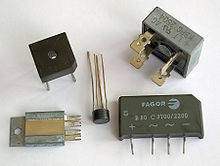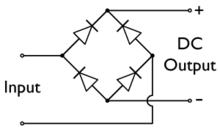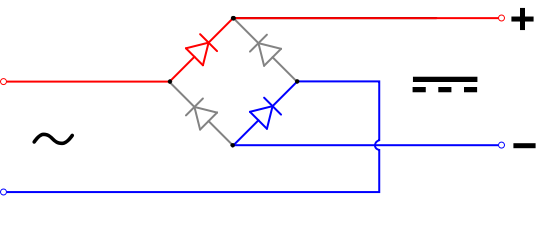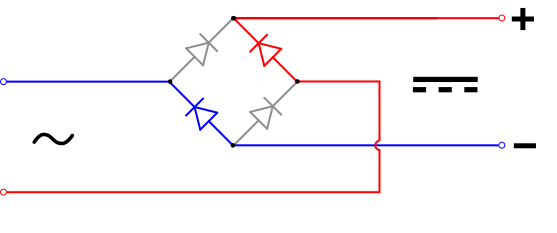| Revision as of 16:30, 30 October 2017 editSbalfour (talk | contribs)Extended confirmed users, Pending changes reviewers26,512 editsm →Polyphase diode bridges: spurious italicization deleted← Previous edit | Revision as of 01:34, 3 December 2017 edit undoMikhail Ryazanov (talk | contribs)Extended confirmed users23,600 editsm punct., fmt.Next edit → | ||
| Line 1: | Line 1: | ||
| ] | ] | ||
| ] | ] | ||
| A '''diode bridge''' is an arrangement of four (or more) ]s in a ] configuration that provides the same ] of output for either polarity of input. | A '''diode bridge''' is an arrangement of four (or more) ]s in a ] configuration that provides the same ] of output for either polarity of input. | ||
| When used in its most common application, for conversion of an ] (AC) input into a ] (DC) output, it is known as a '''bridge ]'''. A bridge rectifier provides ] from a two-wire AC input, resulting in lower cost and weight as compared to a rectifier with a 3-wire input from a ] with a ] secondary winding.<ref name=AOE>{{cite book |last1=Horowitz |first1=Paul |last2=Hill |first2=Winfield |title=The Art of Electronics|edition=Second|publisher=Cambridge University Press|year=1989|pages=44-47|ISBN=0-521-37095-7}}</ref> | When used in its most common application, for conversion of an ] (AC) input into a ] (DC) output, it is known as a '''bridge ]'''. A bridge rectifier provides ] from a two-wire AC input, resulting in lower cost and weight as compared to a rectifier with a 3-wire input from a ] with a ] secondary winding.<ref name=AOE>{{cite book |last1=Horowitz |first1=Paul |last2=Hill |first2=Winfield |title=The Art of Electronics|edition=Second|publisher=Cambridge University Press|year=1989|pages=44-47|ISBN=0-521-37095-7}}</ref> | ||
| The essential feature of a diode bridge is that the polarity of the output is the same regardless of the polarity at the input. The diode bridge circuit was invented by ] ] ] | The essential feature of a diode bridge is that the polarity of the output is the same regardless of the polarity at the input. The diode bridge circuit was invented by ] ] ] | ||
| <ref></ref> and patented on 14 Jan |
<ref>.</ref> and patented on 14 Jan 1896 under the number DRP<ref>{{cite web |url=http://www.assistedknife.com/index.cfm/fa/subcategories.main/parentcat/26847/subcatid/80975 |title=D.R.P. and D.R.G.M. |deadurl=yes |archiveurl=https://web.archive.org/web/20130817060151/http://www.assistedknife.com/index.cfm/fa/subcategories.main/parentcat/26847/subcatid/80975 |archivedate=2013-08-17 |df= }}</ref> 96564. It was later published in ''Elektronische Zeitung'', vol. 25 in 1897 with annotation that ] ] ] also was researching this matter at that time.<ref>Strzelecki, R. . Springer, 2008, p. 57.</ref> Today the circuit is still often referred to as a '''Graetz circuit''' or '''Graetz bridge'''.<ref>{{cite web|url=http://www.mathworks.in/help/physmod/hydro/examples/graetz-flow-control-circuit.html |title=Graetz Flow Control Circuit |deadurl=yes |archiveurl=https://web.archive.org/web/20131104072407/http://www.mathworks.in/help/physmod/hydro/examples/graetz-flow-control-circuit.html |archivedate=2013-11-04 |df= }}</ref> | ||
| Prior to the availability of ]s, a bridge rectifier was constructed from "discrete components", i.e., separate diodes. Since about 1950, a single four-terminal component containing the four diodes connected in a bridge configuration became a standard commercial component and is now available with various ] |
Prior to the availability of ]s, a bridge rectifier was constructed from "discrete components", i.e., separate diodes. Since about 1950, a single four-terminal component containing the four diodes connected in a bridge configuration became a standard commercial component and is now available with various ] and current ratings. | ||
| Diodes are also used in bridge topologies along with capacitors as ]s. | Diodes are also used in bridge topologies along with capacitors as ]s. | ||
| ==Current flow== | ==Current flow== | ||
| According to the ] of ] flow (originally established by ] and still followed by most engineers today<ref>Stutz, Michael (stutz@dsl.org), </ref>), current is defined to be positive when it flows through ]s from the ''positive'' to the ''negative'' pole. In actuality, ] in a conductor nearly always flow from the ''negative'' to the ''positive'' pole. In the vast majority of applications, however, the ''actual'' direction of current flow is irrelevant. Therefore, in the discussion below the conventional model is retained. | According to the ] of ] flow (originally established by ] and still followed by most engineers today<ref>Stutz, Michael (stutz@dsl.org), , ''All About Circuits'', Vol. 1, Chapter 1, 2000.</ref>), current is defined to be positive when it flows through ]s from the ''positive'' to the ''negative'' pole. In actuality, ] in a conductor nearly always flow from the ''negative'' to the ''positive'' pole. In the vast majority of applications, however, the ''actual'' direction of current flow is irrelevant. Therefore, in the discussion below the conventional model is retained. | ||
| The fundamental characteristic of a diode is that current can flow only one way through it, which is defined as the forward direction. A diode bridge uses diodes as series components to allow current to pass in the forward direction during the positive part of the AC cycle |
The fundamental characteristic of a diode is that current can flow only one way through it, which is defined as the forward direction. A diode bridge uses diodes as series components to allow current to pass in the forward direction during the positive part of the AC cycle and as shunt components to redirect current flowing in the reverse direction during the negative part of the AC cycle to the opposite rails. | ||
| ==Rectifier== | ==Rectifier== | ||
| In the diagrams below, when the input connected to the left corner of the diamond is ''positive'', and the input connected to the right corner is ''negative'', | In the diagrams below, when the input connected to the left corner of the diamond is ''positive'', and the input connected to the right corner is ''negative'', current flows from the ''upper'' supply terminal to the right along the ''red'' (positive) path to the output and returns to the lower supply terminal through the ''blue'' (negative) path. | ||
| current flows from the ''upper'' supply terminal to the right along the ''red'' (positive) path to the output, and returns to the lower supply terminal via the ''blue'' (negative) path. | |||
| ] | ] | ||
| When the input connected to the left corner is ''negative'', and the input connected to the right corner is ''positive'', current flows from the ''lower'' supply terminal to the right along the ''red'' (positive) path to the output |
When the input connected to the left corner is ''negative'', and the input connected to the right corner is ''positive'', current flows from the ''lower'' supply terminal to the right along the ''red'' (positive) path to the output and returns to the upper supply terminal through the ''blue'' (negative) path.<ref name=SZY>Sears, Francis W., Mark W. Zemansky and Hugh D. Young, ''University Physics'', Sixth Ed., Addison-Wesely Publishing Co., Inc., 1982, p. 685.</ref> | ||
| ] | ] | ||
| Line 28: | Line 28: | ||
| ] | ] | ||
| In each case, the upper right output remains positive and lower right output negative. Since this is true whether the input is AC or DC, this circuit not only produces a DC output from an AC input, it can also provide what is sometimes called "reverse |
In each case, the upper right output remains positive, and lower right output negative. Since this is true whether the input is AC or DC, this circuit not only produces a DC output from an AC input, it can also provide what is sometimes called "reverse-polarity protection". That is, it permits normal functioning of DC-powered equipment when ] have been installed backwards, or when the leads (wires) from a DC power source have been reversed, and protects the equipment from potential damage caused by reverse polarity. | ||
| Alternatives to the diode |
Alternatives to the diode-bridge full-wave rectifiers are the ], and ] rectifier using two diodes and two capacitors in a bridge topology. | ||
| ] and full |
] and full-wave rectified signals<ref name="CEST">"Rectifier", ''Concise Encyclopedia of Science and Technology'', Third Edition, Sybil P. Parker, ed. McGraw-Hill, Inc., 1994, p. 1589.</ref>]] | ||
| ==Smoothing== | ==Smoothing== | ||
| {{unreferenced|section|date=October 2017}} | {{unreferenced|section|date=October 2017}} | ||
| {{See also|Rectifier#Rectifier output smoothing}} | {{See also|Rectifier#Rectifier output smoothing}} | ||
| With AC input, the output of a diode bridge (called a ] for this purpose; there is also ] which does not use a diode bridge) is polarized pulsating ] voltage of the same amplitude but twice the frequency of the input. It may be considered as DC voltage upon which is superimposed a very large ]. This kind of electric power is not very usable, because ripple is dissipated as waste heat in DC circuit components |
With AC input, the output of a diode bridge (called a ] for this purpose; there is also ], which does not use a diode bridge) is polarized pulsating ] voltage of the same amplitude but twice the frequency of the input. It may be considered as DC voltage upon which is superimposed a very large ]. This kind of electric power is not very usable, because ripple is dissipated as waste heat in DC circuit components and may cause noise or distortion during circuit operation. So nearly all rectifiers are followed by a series of ] or ]s and/or a ] to convert most or all of the ripple voltage into a smoother and possibly higher DC output. A filter may be as simple as a single sufficiently large ] or ], but most power-supply filters have multiple alternating series and shunt components. When the ripple voltage rises, ] is stored in the filter components, reducing the voltage; when the ripple voltage falls, reactive power is discharged from the filter components, raising the voltage. The final stage of rectification may consist of a ]-based voltage regulator, which almost completely eliminates any residual ripple. | ||
| into a smoother and possibly higher DC output. A filter may be as simple as a single sufficiently large ] or ] but most power supply filters have multiple alternating series and shunt components. When the ripple voltage rises, ] is stored in the filter components reducing the voltage; when the ripple voltage falls, reactive power is discharged from the filter components raising the voltage. The final stage of rectification may consist of a ] based voltage regulator which almost completely eliminates any residual ripple. | |||
| ==Polyphase diode bridges== | ==Polyphase diode bridges== | ||
| Line 44: | Line 43: | ||
| The diode bridge can be generalized to rectify ] AC inputs. For example, for a three-phase AC input, a half-wave rectifier consists of three diodes, but a full-wave bridge rectifier consists of six diodes. | The diode bridge can be generalized to rectify ] AC inputs. For example, for a three-phase AC input, a half-wave rectifier consists of three diodes, but a full-wave bridge rectifier consists of six diodes. | ||
| Half-wave rectifier may be considered as wye connection (star connection), because it returns the current through the centre (neutral) wire. Full-wave is more like delta connection, although it can be connected to the three |
Half-wave rectifier may be considered as wye connection (star connection), because it returns the current through the centre (neutral) wire. Full-wave is more like delta connection, although it can be connected to the three-phase source of either wye or delta and it does not use the centre (neutral) wire. | ||
| ] | ] | ||
| ] | ] | ||
| ] |
]]] | ||
| {{Clear}} | |||
| ==Diode switching artifacts and snubber circuits== | ==Diode switching artifacts and snubber circuits== | ||
| Power |
Power-supply transformers have leakage inductance and parasitic capacitance. When the diodes in a bridge rectifier switch off, these "non-ideal" elements form a resonant circuit, which can oscillate at high frequency. This high-frequency oscillation can then couple into the rest of the circuitry. Snubber circuits are used in an attempt to mitigate this problem. A snubber circuit consists of either a very small capacitor or series capacitor and resistor across a diode. | ||
| of either a very small capacitor or series capacitor and resistor across a diode. | |||
| ==See also== | ==See also== | ||
Revision as of 01:34, 3 December 2017


A diode bridge is an arrangement of four (or more) diodes in a bridge circuit configuration that provides the same polarity of output for either polarity of input.
When used in its most common application, for conversion of an alternating-current (AC) input into a direct-current (DC) output, it is known as a bridge rectifier. A bridge rectifier provides full-wave rectification from a two-wire AC input, resulting in lower cost and weight as compared to a rectifier with a 3-wire input from a transformer with a center-tapped secondary winding.
The essential feature of a diode bridge is that the polarity of the output is the same regardless of the polarity at the input. The diode bridge circuit was invented by Polish electrotechnician Karol Pollak and patented on 14 Jan 1896 under the number DRP 96564. It was later published in Elektronische Zeitung, vol. 25 in 1897 with annotation that German physicist Leo Graetz also was researching this matter at that time. Today the circuit is still often referred to as a Graetz circuit or Graetz bridge.
Prior to the availability of integrated circuits, a bridge rectifier was constructed from "discrete components", i.e., separate diodes. Since about 1950, a single four-terminal component containing the four diodes connected in a bridge configuration became a standard commercial component and is now available with various voltage and current ratings.
Diodes are also used in bridge topologies along with capacitors as voltage multipliers.
Current flow
According to the conventional model of current flow (originally established by Benjamin Franklin and still followed by most engineers today), current is defined to be positive when it flows through electrical conductors from the positive to the negative pole. In actuality, free electrons in a conductor nearly always flow from the negative to the positive pole. In the vast majority of applications, however, the actual direction of current flow is irrelevant. Therefore, in the discussion below the conventional model is retained.
The fundamental characteristic of a diode is that current can flow only one way through it, which is defined as the forward direction. A diode bridge uses diodes as series components to allow current to pass in the forward direction during the positive part of the AC cycle and as shunt components to redirect current flowing in the reverse direction during the negative part of the AC cycle to the opposite rails.
Rectifier
In the diagrams below, when the input connected to the left corner of the diamond is positive, and the input connected to the right corner is negative, current flows from the upper supply terminal to the right along the red (positive) path to the output and returns to the lower supply terminal through the blue (negative) path.
When the input connected to the left corner is negative, and the input connected to the right corner is positive, current flows from the lower supply terminal to the right along the red (positive) path to the output and returns to the upper supply terminal through the blue (negative) path.

In each case, the upper right output remains positive, and lower right output negative. Since this is true whether the input is AC or DC, this circuit not only produces a DC output from an AC input, it can also provide what is sometimes called "reverse-polarity protection". That is, it permits normal functioning of DC-powered equipment when batteries have been installed backwards, or when the leads (wires) from a DC power source have been reversed, and protects the equipment from potential damage caused by reverse polarity.
Alternatives to the diode-bridge full-wave rectifiers are the center-tapped transformer and double-diode rectifier, and voltage doubler rectifier using two diodes and two capacitors in a bridge topology.

Smoothing
| This section does not cite any sources. Please help improve this section by adding citations to reliable sources. Unsourced material may be challenged and removed. Find sources: "Diode bridge" – news · newspapers · books · scholar · JSTOR (October 2017) (Learn how and when to remove this message) |
With AC input, the output of a diode bridge (called a full-wave rectifier for this purpose; there is also half-wave rectification, which does not use a diode bridge) is polarized pulsating non-sinusoidal voltage of the same amplitude but twice the frequency of the input. It may be considered as DC voltage upon which is superimposed a very large ripple voltage. This kind of electric power is not very usable, because ripple is dissipated as waste heat in DC circuit components and may cause noise or distortion during circuit operation. So nearly all rectifiers are followed by a series of bandpass or bandstop filters and/or a voltage regulator to convert most or all of the ripple voltage into a smoother and possibly higher DC output. A filter may be as simple as a single sufficiently large capacitor or choke, but most power-supply filters have multiple alternating series and shunt components. When the ripple voltage rises, reactive power is stored in the filter components, reducing the voltage; when the ripple voltage falls, reactive power is discharged from the filter components, raising the voltage. The final stage of rectification may consist of a zener diode-based voltage regulator, which almost completely eliminates any residual ripple.
Polyphase diode bridges
See also: Rectifier § Three-phase rectifiersThe diode bridge can be generalized to rectify polyphase AC inputs. For example, for a three-phase AC input, a half-wave rectifier consists of three diodes, but a full-wave bridge rectifier consists of six diodes.
Half-wave rectifier may be considered as wye connection (star connection), because it returns the current through the centre (neutral) wire. Full-wave is more like delta connection, although it can be connected to the three-phase source of either wye or delta and it does not use the centre (neutral) wire.



Diode switching artifacts and snubber circuits
Power-supply transformers have leakage inductance and parasitic capacitance. When the diodes in a bridge rectifier switch off, these "non-ideal" elements form a resonant circuit, which can oscillate at high frequency. This high-frequency oscillation can then couple into the rest of the circuitry. Snubber circuits are used in an attempt to mitigate this problem. A snubber circuit consists of either a very small capacitor or series capacitor and resistor across a diode.
See also
- 1N400x general-purpose diodes also called rectifier diodes
- Active rectification
- HVDC converter
References
- Horowitz, Paul; Hill, Winfield (1989). The Art of Electronics (Second ed.). Cambridge University Press. pp. 44–47. ISBN 0-521-37095-7.
- British patent 24398.
- "D.R.P. and D.R.G.M." Archived from the original on 2013-08-17.
{{cite web}}: Unknown parameter|deadurl=ignored (|url-status=suggested) (help) - Strzelecki, R. Power Electronics in Smart Electrical Energy Networks. Springer, 2008, p. 57.
- "Graetz Flow Control Circuit". Archived from the original on 2013-11-04.
{{cite web}}: Unknown parameter|deadurl=ignored (|url-status=suggested) (help) - Stutz, Michael (stutz@dsl.org), "Conventional versus electron flow", All About Circuits, Vol. 1, Chapter 1, 2000.
- Sears, Francis W., Mark W. Zemansky and Hugh D. Young, University Physics, Sixth Ed., Addison-Wesely Publishing Co., Inc., 1982, p. 685.
- "Rectifier", Concise Encyclopedia of Science and Technology, Third Edition, Sybil P. Parker, ed. McGraw-Hill, Inc., 1994, p. 1589.
External links
- "Converting AC to DC: "Bridge Rectifiers" (USAF Training Film, 1969)". Jeff Quitney (YouTube). May 31, 2017.
| Bridge circuits | |
|---|---|
| Resistance | |
| Resistance–Capacitance | |
| General | |
| Inductance | |
| Other | |

